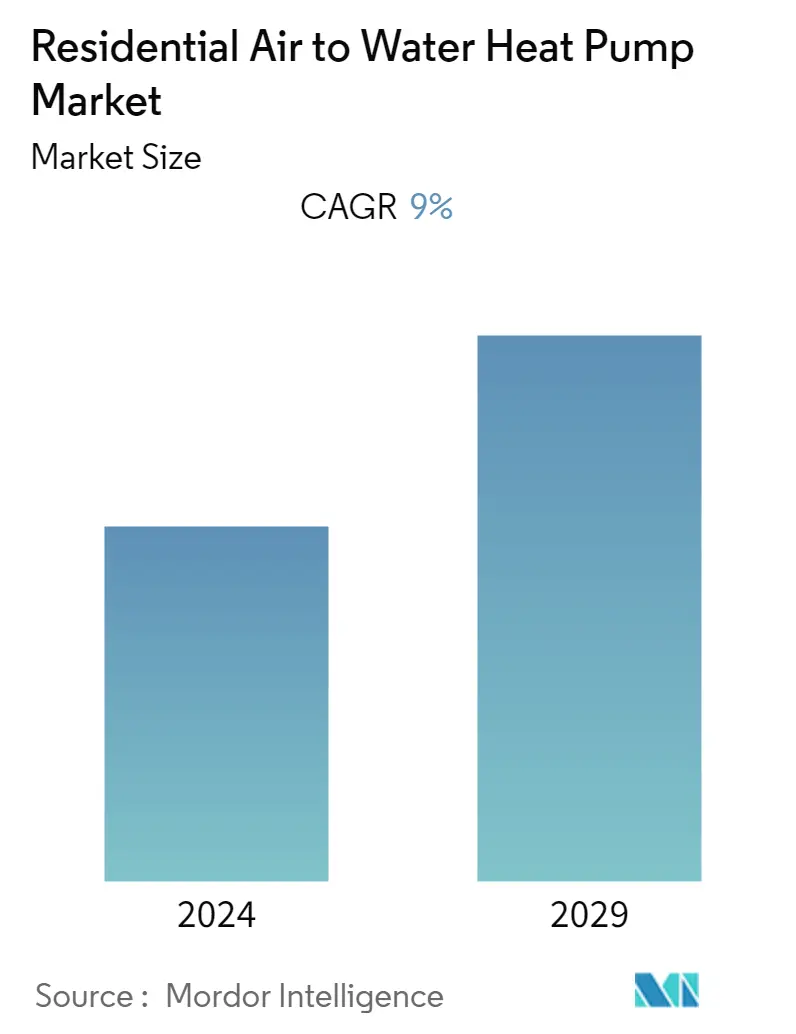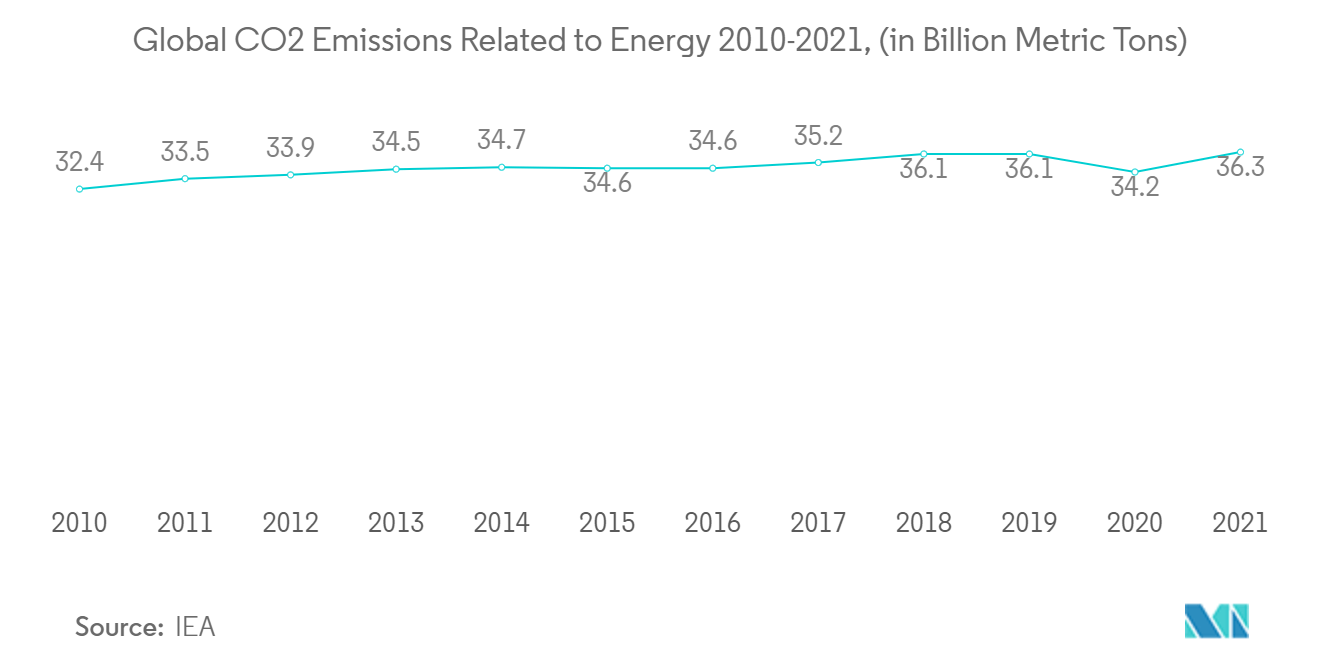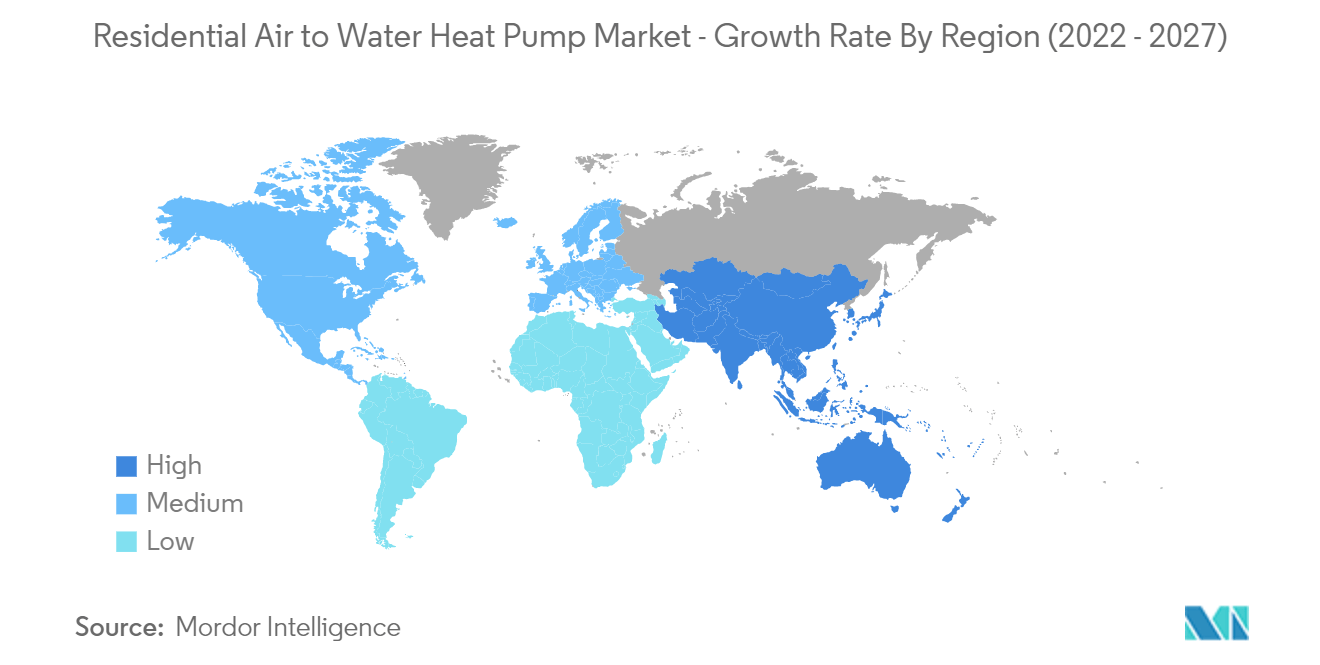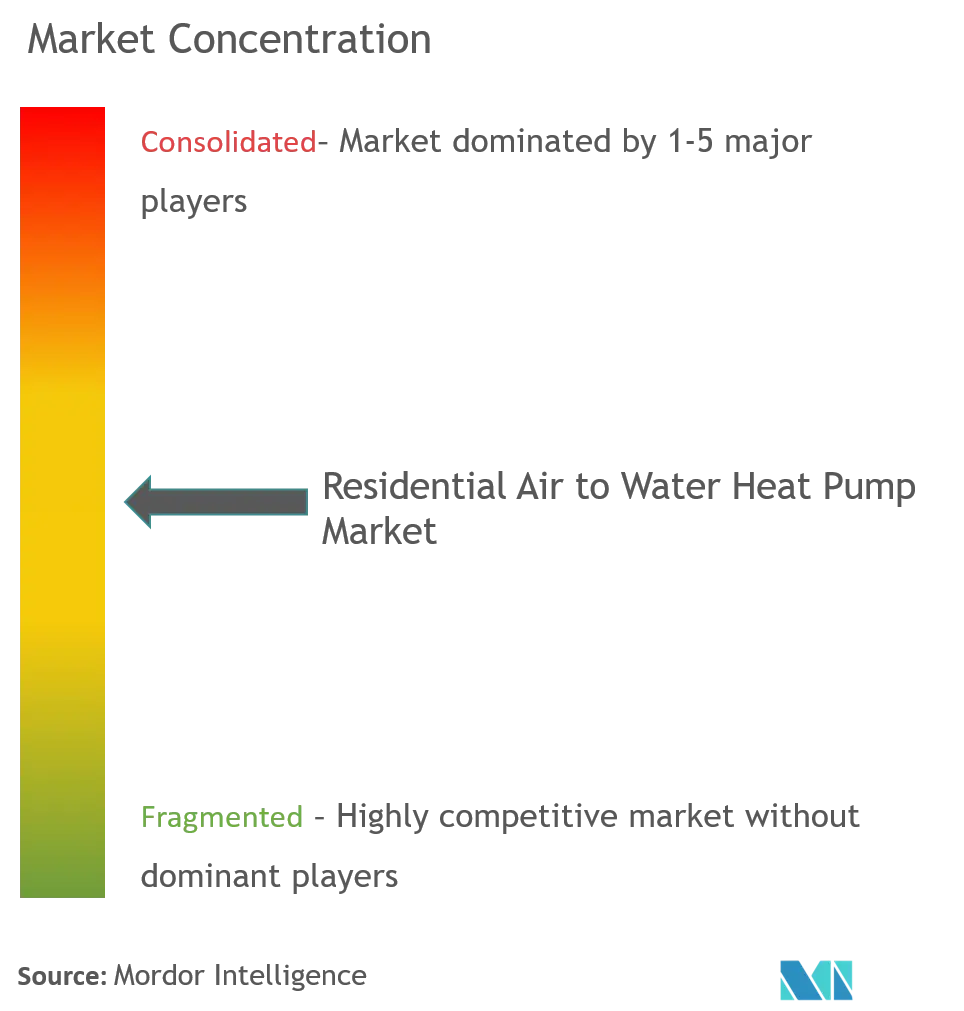Residential Air to Water Heat Pump Market Size

| Study Period | 2019 - 2029 |
| Base Year For Estimation | 2023 |
| CAGR | 9.00 % |
| Fastest Growing Market | Asia Pacific |
| Largest Market | North America |
| Market Concentration | Medium |
Major Players
*Disclaimer: Major Players sorted in no particular order |
Residential Air to Water Heat Pump Market Analysis
The Global Residential Air-to-Water Heat Pump Market is expected to register a CAGR of 9% over the forecast period.
A favorable regulatory framework, coupled with clean cooling & heating programs to promote the enactment of heating, ventilation, and air conditioning (HVAC) units, will positively influence the residential air-to-water heat pump market share. Continuous approval and deployment of sustainable systems to lessen the adverse environmental influence are expected to further accelerate product regression. The growing shift toward sustainable solutions to reduce energy consumption is one of the major factors that is driving the adoption of air-to-water heat pumps for residential use. Governments across all regions play a major role in reducing energy consumption.
The development in the residential sector in line with the growing urban population is also a factor influencing the market's growth. According to FMI Corporation, in 2020, new residential construction in the United States increased by USD 15.0 billion, despite the impact of the COVID-19 pandemic. Such growth creates new opportunities for the market.
According to International Energy Agency, the number of heat pumps installed globally is expected to rise from 180.0 million in 2020 to around 600.0 million in the next few years. At least three times more efficient than traditional fossil fuel boilers, the installation of heat pumps in individual buildings is expected to rise from 1.5 million per month currently to around 5.0 million in the next few years. Although heat pumps have even become the most common technology in newly built houses in many countries, they meet only 5.0% of the global building heating demand, thus creating new opportunities for the market.
The COVID-19 pandemic affected investments in energy-efficient technologies. According to International Energy Agency (IEA) World Energy Investment 2020, investment in energy-efficient technologies in 2020 fell due to the economic downturn. In addition, the pandemic led to an effect on the supply chain of the major players in the market owing to the lockdowns and restrictions on working capacity. Companies, such as Daikin and Fujitsu, among others, experienced backhauls due to supply chain disruptions.
Residential Air to Water Heat Pump Market Trends
This section covers the major market trends shaping the Residential Air to Water Heat Pump Market according to our research experts:
Meaningful Contribution of Heat Pumping Technology in Reduction of CO2 Emissions Drives Market
- Energy is necessary for daily life as it fuels businesses, hospitals, powered homes, and schools. However, energy generation leads to the discharge of greenhouse gases. As per EIA, energy consumption in the United States produced 4.87 billion metric tons of carbon dioxide (GtCO2) in 2021, an increase of 6.5% from 2020 levels. In 2020, emissions plummeted by 11% as a result of the outbreak of COVID-19, which heavily disrupted industry and travel.
- Carbon dioxide (CO2), which is one of the greenhouse gases, is released substantially through the burning of fossil fuels, such as coal, oil, and natural gas. Many countries aim to reduce their primary energy demand due to rising CO2 emissions and implement policies to limit greenhouse gases in the environment. The Residential Air to Water Heat Pump offers an energy-efficient way to provide space heating, thus fueling the market's growth.
- Carbon emissions associated with energy consumption and generation can be decreased considerably when air-to-water heat pump systems are utilized instead of fossil-fueled methods. This is driving a rise in the number of residential complexes with energy-efficient heat pump installations.
- On similar lines, in June 2021, the United States Environmental Protection Agency (EPA) announced advancements to the Energy Star program to reduce emissions by more than 50% by 2030. The authority upgraded the Energy Star standards for residential water heaters and heating/cooling equipment that advance innovative heat pump technology.
- The upgraded standards will be used as a key component to reduce carbon pollution and reduce energy and heating costs. It is estimated that if all central air conditioners, heat pumps, and electric water heaters sold in the United States met the new Energy Star standards, the savings are expected to increase to USD 11.0 billion a year. It may also avoid 255.0 billion pounds of greenhouse gases per year, which equals one-third of all direct greenhouse gas emissions from homes and apartments in the United States.

United States to Dominate the Market
- Air-to-water heat pumps have been utilized for many years in almost all parts of the United States except those that experienced extended periods of subfreezing temperatures. However, air-to-water heat pump technology has advanced in the last few years, which now offers a legitimate space heating alternative in colder regions.
- The US market is gradually catching up with other regions, such as China and Japan, as contractors embrace the coefficient of performance (COP) race, developing energy savings and environmentally friendly heating and cooling technology.
- Additionally, the US market is anticipated to witness substantial growth due to the growing concerns about controlling carbon footprints, coupled with the installation of government drives to support the adoption of residential air-to-water heat pump units. According to the EIA, it is estimated that 62.0 million metric tons of CO2 emissions will be produced using petroleum in the commercial sector in the United States by 2050.
- According to the United States Census Bureau and the US Department of Housing and Urban Development, privately owned housing started in August 2021 at a seasonally adjusted annual rate of 1,615,000, 3.9% above the revised July 2021 estimate of 1,554,000 and was 17.45% above the August 2020 rate of 1,376,000. The increase in construction activities creates new demand for air-to-water heat pumps.
- Growing demand for water and space heating, coupled with a rapidly recovering construction industry in the United States and complemented with repair and renovation activities, is projected to drive the demand for technologically advanced and compact heating solutions in the residential sector. For instance, according to BEA, the value-added construction industry contributed to 4.1% of the gross domestic product in the United States. It is anticipated that new construction put in place will total USD 1,449 billion by 2023.

Residential Air to Water Heat Pump Industry Overview
The Residential Air to Water Heat Pump Market is moderately competitive and consists of several major players. The competitive rivalry in the residential air-to-water heat pump market is moderately high due to the presence of some major players, such as Daikin Industries Ltd, Mitsubishi Electric Europe BV, Ariston Thermo SpA, Ferroli S.p.A, and Baxi Heating UK Ltd, among others. Their strength to continually innovate their offerings has given them a competitive advantage over other players in the market. These players have increased their market footprint through mergers and acquisitions and research and development activities.
In September 2022, Panasonic stated that it plans to invest approximately EUR 145.0 million (around USD 144.8 million) to increase heat pump production at its Czech Republic factory to 500,000 units by the end of March 2026. In 2018, Panasonic began production of air-to-water indoor units with a single line at its TV factory in Plzen. Panasonic's decision to discontinue TV production at the plant last year due to the falling demand created extra capacity for heat pump production. In September 2021, under the production-linked incentive (PLI) plan for white goods, Daikin, a Japanese air conditioning company, purchased land for a new factory. Daikin India, the multinational's India unit, completed the acquisition deal for a 75-acre site in Sri City (Andhra Pradesh) to build a huge air-conditioning (AC) manufacturing plant in phases. According to internal estimations, Daikin will have to invest INR 1,000 crore in the first phase.
Residential Air to Water Heat Pump Market Leaders
-
Daikin Industries Ltd
-
Mitsubishi Electric Europe B.V
-
Ariston Thermo SpA
-
Ferroli S.p.A
-
Baxi Heating UK Ltd (BDR Thermia Group)
*Disclaimer: Major Players sorted in no particular order

Residential Air to Water Heat Pump Market News
- June 2021: The Chinese company, OEM PHNIX, launched a GreenThermSeries air-to-water propane (R290) heat pump with inverter EVI technology, targeting the European market. The GreenThermheat pump operates in temperatures as low as -25 degrees Celsius. The heat pump generates hot water temperatures of up to 70 degrees Celsius, with noise as low as 42 dB(A).
- March 2021: Daikin Manufacturing Germany announced the expansion of its facility in line with its commitment to making Germany and Europe climate-neutral economies by 2050. The new production line will enable Daikin to produce wall-mounted indoor heat pump units used in several product ranges. With the new production facility, Daikin aims to strengthen its footprint in Europe's leading manufacturing hub and key heating market at the core of the energy transition.
Residential Air to Water Heat Pump Market Report - Table of Contents
1. INTRODUCTION
- 1.1 Study Assumptions and Market Definition
- 1.2 Scope of the Study
2. RESEARCH METHODOLOGY
3. EXECUTIVE SUMMARY
4. MARKET INSIGHTS
- 4.1 Market Overview
-
4.2 Industry Attractiveness - Porter's Five Forces Analysis
- 4.2.1 Bargaining Power of Suppliers
- 4.2.2 Bargaining Power of Consumers
- 4.2.3 Threat of New Entrants
- 4.2.4 Intensity of Competitive Rivalry
- 4.2.5 Threat of Substitute Products
- 4.3 Impact of COVID-19 on the Heat Pump Industry
5. MARKET DYNAMICS
-
5.1 Market Drivers
- 5.1.1 Increasing Demand for Energy-efficient Systems
- 5.1.2 Favorable Measures to Reduce Carbon Footprints
-
5.2 Market Challenges
- 5.2.1 High Upfront Costs
- 5.2.2 Low Co-efficient of Performance (COP) Levels
6. MARKET SEGMENTATION
-
6.1 Geography
- 6.1.1 United States
- 6.1.2 China
- 6.1.3 France
- 6.1.4 Italy
- 6.1.5 Rest of the World
7. COMPETITIVE LANDSCAPE
-
7.1 Company Profiles
- 7.1.1 Daikin Industries Ltd
- 7.1.2 Mitsubishi Electric Europe B.V
- 7.1.3 Ariston Thermo SpA
- 7.1.4 Ferroli S.p.A
- 7.1.5 Baxi Heating UK Ltd (BDR Thermia Group)
- 7.1.6 Aermec SpA
- 7.1.7 Clivet S.p.A
- 7.1.8 Tecnocasa climatizzazione s.r.l.
- 7.1.9 Toshiba Corporation
- 7.1.10 Panasonic Corporation
- 7.1.11 Vaillant Group
- 7.1.12 Swegon Group AB
- 7.1.13 NIBE Industrier AB
- *List Not Exhaustive
8. INVESTMENT ANALYSIS
9. MARKET OPPORTUNITIES AND FUTURE TRENDS
** Subject To AvailablityResidential Air to Water Heat Pump Industry Segmentation
Air-to-water heat pumps can provide adequate heating and cooling for houses, particularly in a moderate climate. After proper installation, an air-to-water heat pump can give one and a half to three times more thermal energy to a home than the electricity it uses. Air-to-water heat pumps do not work very well under freezing temperatures. Air-to-water heat pumps specially designed for cold climates have started to provide encouraging results.
The residential air-to-water heat pumps are segmented by geography (United States, China, France, Italy, and the Rest of the World). The market also includes an assessment of the impact of COVID-19 on the market. For each segment, the market sizing and forecasts have been provided on the basis of value (in USD million) and volume (in metric tons).
| Geography | United States |
| China | |
| France | |
| Italy | |
| Rest of the World |
Residential Air to Water Heat Pump Market Research FAQs
What is the current Residential Air to Water Heat Pump Market size?
The Residential Air to Water Heat Pump Market is projected to register a CAGR of 9% during the forecast period (2024-2029)
Who are the key players in Residential Air to Water Heat Pump Market?
Daikin Industries Ltd, Mitsubishi Electric Europe B.V, Ariston Thermo SpA, Ferroli S.p.A and Baxi Heating UK Ltd (BDR Thermia Group) are the major companies operating in the Residential Air to Water Heat Pump Market.
Which is the fastest growing region in Residential Air to Water Heat Pump Market?
Asia Pacific is estimated to grow at the highest CAGR over the forecast period (2024-2029).
Which region has the biggest share in Residential Air to Water Heat Pump Market?
In 2024, the North America accounts for the largest market share in Residential Air to Water Heat Pump Market.
What years does this Residential Air to Water Heat Pump Market cover?
The report covers the Residential Air to Water Heat Pump Market historical market size for years: 2019, 2020, 2021, 2022 and 2023. The report also forecasts the Residential Air to Water Heat Pump Market size for years: 2024, 2025, 2026, 2027, 2028 and 2029.
Residential Air to Water Heat Pump Industry Report
Statistics for the 2024 Residential Air to Water Heat Pump market share, size and revenue growth rate, created by Mordor Intelligence™ Industry Reports. Residential Air to Water Heat Pump analysis includes a market forecast outlook 2029 and historical overview. Get a sample of this industry analysis as a free report PDF download.



